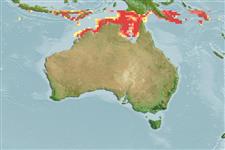Elasmobranquios (tiburones y rayas) (sharks and rays) >
Myliobatiformes (Stingrays) >
Dasyatidae (Stingrays) > Neotrygoninae
More on author: Last.
Environment: milieu / climate zone / depth range / distribution range
Ecología
marino demersal; rango de profundidad 10 - 62 m (Ref. 6871). Deep-water; 8°S - 16°S
Distribución
Países | Áreas FAO | Ecosistemas | Ocurrencias, apariciones | Point map | Introducciones | Faunafri
Eastern Indian Ocean and Southwest Pacific: northern Australia, southern New Guinea and eastern Indonesia.
Length at first maturity / Tamaño / Peso / Age
Maturity: Lm 20.3, range 18 - 22 cm
Max length : 45.0 cm TL macho / no sexado; (Ref. 9840)
Found offshore on continental shelf and feeds on bony fishes and crustaceans. Litters of 1-3 pups, born at 12-14 cm WD (Ref. 114953). Ovoviviparous (Ref. 50449)
Life cycle and mating behavior
Madurez | Reproducción | Puesta | Huevos | Fecundidad | Larva
Ovoviviparous (Ref. 205). Distinct pairing with embrace (Ref. 205).
Last, P.R. and J.D. Stevens, 1994. Sharks and rays of Australia. CSIRO, Australia. 513 p. (Ref. 6871)
IUCN Red List Status (Ref. 130435: Version 2024-1)
Threat to humans
Harmless
Human uses
Pesquerías: sin interés
Herramientas
Special reports
Download XML
Fuentes de Internet
Estimates based on models
Preferred temperature (Ref.
123201): 27.1 - 28.7, mean 28 °C (based on 140 cells).
Phylogenetic diversity index (Ref.
82804): PD
50 = 0.5039 [Uniqueness, from 0.5 = low to 2.0 = high].
Bayesian length-weight: a=0.01096 (0.00350 - 0.03435), b=3.12 (2.87 - 3.37), in cm total length, based on LWR estimates for this (Sub)family-body shape (Ref.
93245).
Nivel trófico (Ref.
69278): 3.4 ±0.3 se; based on size and trophs of closest relatives
Resiliencia (Ref.
120179): Bajo, población duplicada en un tiempo mínimo de 4.5-14 años (Assuming fecundity<100).
Fishing Vulnerability (Ref.
59153): Low to moderate vulnerability (35 of 100).
